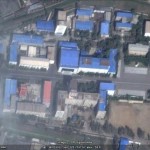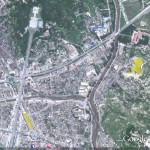According to the New York Times:
North Korea on Monday gave South Korean tourism officials 72 hours to leave a mountain resort, saying it would start auctioning off South Korean-owned hotels, restaurants and other remnants of what used to be a symbol of inter-Korean cooperation.
…
North Korea gave the ultimatum on Monday after talks failed to resolve a dispute over whether tourism in the resort should resume and under what conditions.
“We consider that the South has completely given up all rights on properties owned by South Korean companies and now start legal disposal of them,” the North’s official Korean Central News Agency quoted the North Korean tourism authorities as saying. “All assets owned by South Korean companies in the Geumgangsan resort are banned from being taken out as of Aug. 21.”
The South Korean assets in the resort amount to 480 billion won, or $443 million, according to government data. North Korea said last year that it had confiscated the assets, including a spa, a duty-free shop and other businesses built and owned by the South Korean government.
Fourteen South Koreans were staying in the area maintaining facilities owned by Hyundai and other private South Korean investors. The Unification Ministry, a South Korean government agency in charge of inter-Korean relations, said it would take “all possible diplomatic and legal measures to protect the property rights of our government and enterprises.”
Hyundai Asan, which developed and ran the resort, warned that anyone who bought facilities at the resort would be implicated in international lawsuits.
After attracting 2 million South Korean tourists by sea or by a road built across the nations’ heavily armed border, the project came to an abrupt halt in 2008, after the female South Korean tourist strayed outside the tourism zone one morning and was shot and killed by North Korean soldiers.
Xinhua, the Chinese state media outlet reports that the South Koreans have rejected this move by the North Koreans:
“The government cannot accept North Korea (DPRK)’s arbitrary measures, and we’d like to make it clear the North should be held responsible for all consequences,” Chun Hae-sung, spokesman for the unification ministry in Seoul, told reporters.
“The government will seek all necessary measures including legal and diplomatic ones, and will stay in close contact with business operators involved,” he added, calling Pyongyang’s announcement “regrettable.” The ministry oversees inter-Korean affairs.
The Choson Ilbo points out some additional points of economic interest:
The greatest concern for South Korean officials is the potential conflict over power generators Hyundai Asan installed at Kosong Port to supply electricity to the resort. Since 2008, Hyundai has been operating only one of them to supply power for the remaining staff. If Asan halts the power generators, North Korea cannot use the facilities in the resort. This may be why the North has threatened to take “stern measures” should South Korea “cause damage to assets” left in the resort.
While freezing the South Korean assets, North Korea has been trying to organize tours to Mt. Kumgang on its own. Some analysts say the North hopes to get another country to operate the tours to generate hard cash. Until the tours were suspended in 2008, North Korea made US$487 million from Hyundai Asan.
A separate Choson Ilbo article questions whether the operation will be as profitable if targeted at non-South Koreans:
But of the total 1.93 million visitors to the resort between 1998 and 2008, non-Koreans accounted for only 12,817, or less than 1 percent, which comes to just four a day. It was South Koreans who were willing to pay a large amount of money, including fees to cross the border, to briefly set foot on Korean soil on the other side of the demilitarized zone, But for foreigners, the resort is just a place in the middle of nowhere.
Foreign investors who were cautiously calculating the viability of investments in North Korea were probably shocked to see the seizure of South Korean assets. The North scrapped a 50-year contract with Asan as if it was not worth the paper it was written on and even invented a new law enabling it to sign a deal with somebody else. Which investor in his right mind would want to put his money in a country like that?
The Donga Ilbo breaks down the cost of the fixed capital investments Hyundai-Asan made in the Kumgang Resort:
South Korean assets seized by the North are worth 484.1 billion won (447.2 million dollars). Of the amount, Hyundai Asan invested 226.9 billion won (209.6 million dollars), including hotels in the resort, and the South Korean government spent 124.2 billion won (114.7 million dollars) to build a meeting venue for Korean families separated during the Korean War, duty-free shops and a cultural hall.
Hyundai Asan’s three power generators with a capacity of 1,700 kilometers at Goseong dock are one of the major assets in the tourist region.
North Korea, however, is unlikely to attract foreign tourists to Mount Kumgang on its own or sell the facility to foreign investors. It continues to search for a new partner in China, Japan and the U.S.
Rumor also has it that that North Korean leader Kim Jong Il has ordered that the Mount Kumgang tour be made into a luxury business but low feasibility has prevented progress in the project.
A timeline of Kumgang stories from the shooting until the present can be found here.
Read the full stories here:
North Korea to Auction Resort Owned by South
New York Times
Choe Sang-hun
2011-8-22
S. Korea rejects DPRK’s threatened disposal of properties
Xinhua
2011-8-22
N.Korea Orders S.Koreans Out of Mt. Kumgang
Choson Ilbo
2011-8-23
N.Korea Shoots Itself in the Foot Again
Choson Ilbo
2011-8-23
NK declares disposal of S.Korean assets in Mount Kumgang
Donga Ilbo
2011-8-23


